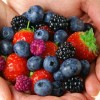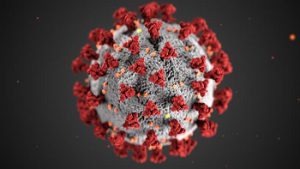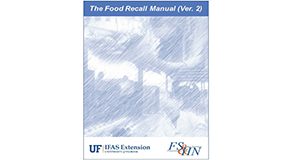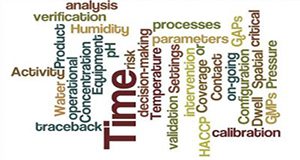These flyers, written by Natalie Seymour, Mary Yavelak, Candice Christian, and Ben Chapman (NC State University Extension), provide quick, digestible information regarding prevention of COVID-19 and procedures for food service, grocery stores, and other food-related businesses. This flyer in particular provides guidance regarding food safety at grocery stores. Published by the UF/IFAS Food Science and Human Nutrition Department.
https://edis.ifas.ufl.edu/fs348
Tag: Michelle Danyluk
The Food Recall Manual (Version 2)
Any business involved in the manufacture, processing, packing, holding, or delivery of food to humans needs to understand and address food recalls. When safety concerns arise with food you are manufacturing, you have a legal and ethical responsibility to mitigate any damage to the health and wellbeing of consumers. This manual details what you need to know to effectively understand and handle a food recall. Written by Keith R. Schneider, Renee Goodrich-Schneider, Douglas A. Archer, Michelle D. Danyluk, George L. Baker, and Chris Thomas and published by the UF/IFAS Department of Food Science and Human Nutrition, February 2018.
http://edis.ifas.ufl.edu/fs108
HACCP: An Overview
HACCP is a food safety management system that is used in various segments of the food industry. The objectives of this 4-page fact sheet are to introduce the topic and to summarize the key components of a HACCP program. Written by J. A. Lepper, R. M. Goodrich-Schneider, K. R. Schneider, M. D. Danyluk and A. Sreedharan and published by the UF/IFAS Department of Food Science and Human Nutrition, January 2018.
http://edis.ifas.ufl.edu/fs122
The Food Safety Modernization Act of 2011-Final Rule for Preventive Controls for Human Food

This 7-page fact sheet is one in a series covering the different rules promulgated under the new Food Safety Modernization Act (FSMA), which was signed into law on January 4, 2011. It is intended to provide an overview of the final Preventive Controls for Human Food (PCHF) rule. Written by Jessica A. Lepper, Soohyoun Ahn, Keith R. Schneider, Michelle D. Danyluk, and Renee Goodrich-Schneider and published by the UF/IFAS Department of Food Science and Human Nutrition, January 2018.
http://edis.ifas.ufl.edu/fs301
Outbreaks of Foodborne Illness Associated with Melons
 Despite the manner in which they are prepared, melons are commonly consumed raw without a processing step which would eliminate pathogenic bacteria. For those concerned about the safety of melons, including cantaloupe, honeydew, and watermelon, this 6-page fact sheet lists outbreaks associated with melons in the United States, Canada, and Europe, along with information about the location, pathogen, and incidence of illness. Written by Michelle D. Danyluk, Rachel McEgan, Ashley N. Turner, and Keith R. Schneider, and published by the UF Department of Food Science and Human Nutrition, November 2014. (UF/IFAS Photo by Thomas Wright)
Despite the manner in which they are prepared, melons are commonly consumed raw without a processing step which would eliminate pathogenic bacteria. For those concerned about the safety of melons, including cantaloupe, honeydew, and watermelon, this 6-page fact sheet lists outbreaks associated with melons in the United States, Canada, and Europe, along with information about the location, pathogen, and incidence of illness. Written by Michelle D. Danyluk, Rachel McEgan, Ashley N. Turner, and Keith R. Schneider, and published by the UF Department of Food Science and Human Nutrition, November 2014. (UF/IFAS Photo by Thomas Wright)
http://edis.ifas.ufl.edu/fs258
Survival of Foodborne Pathogens on Berries
 Fresh and frozen berries are popular foods. When berries are picked for fresh consumption, they are usually packed directly without washing because they are highly perishable. There is typically no “kill step” that would eliminate pathogens on fresh or frozen berries. Foodborne illness outbreaks have been associated with the consumption of fresh or frozen berries that were contaminated with pathogenic viruses, parasites, or bacteria. Contamination can occur before or during harvest or during final preparation. This 11-page fact sheet was written by Mary Palumbo, Linda J. Harris, and Michelle D. Danyluk, and published by the UF Department of Food Science and Human Nutrition, November 2014.
Fresh and frozen berries are popular foods. When berries are picked for fresh consumption, they are usually packed directly without washing because they are highly perishable. There is typically no “kill step” that would eliminate pathogens on fresh or frozen berries. Foodborne illness outbreaks have been associated with the consumption of fresh or frozen berries that were contaminated with pathogenic viruses, parasites, or bacteria. Contamination can occur before or during harvest or during final preparation. This 11-page fact sheet was written by Mary Palumbo, Linda J. Harris, and Michelle D. Danyluk, and published by the UF Department of Food Science and Human Nutrition, November 2014.
http://edis.ifas.ufl.edu/fs236
The Food Safety Modernization Act of 2011 – Proposed Rule for Preventive Controls for Human Food
 The Food Safety Modernization Act (FSMA), which was signed into law by President Obama on January 4, 2011, is the most sweeping reform of food safety laws in more than 70 years since the enactment of the Federal Food, Drug and Cosmetic Act of 1938. High-profile foodborne outbreaks in the last decade and their impact on public health and the economy have exposed the need for a new, modern food safety system. FSMA aims to ensure the safety and security of the US food supply by focusing on preventing food safety problems rather than responding after they occur. This law provides the FDA with new enforcement authorities to achieve a higher rate of compliance with food safety standards and to respond better to problems. This 5-page fact sheet was written by Soohyoun Ahn, Keith R. Schneider, Michelle D. Danyluk, and Renee Goodrich-Schneider, and published by the UF Department of Food Science and Human Nutrition, April 2014.
The Food Safety Modernization Act (FSMA), which was signed into law by President Obama on January 4, 2011, is the most sweeping reform of food safety laws in more than 70 years since the enactment of the Federal Food, Drug and Cosmetic Act of 1938. High-profile foodborne outbreaks in the last decade and their impact on public health and the economy have exposed the need for a new, modern food safety system. FSMA aims to ensure the safety and security of the US food supply by focusing on preventing food safety problems rather than responding after they occur. This law provides the FDA with new enforcement authorities to achieve a higher rate of compliance with food safety standards and to respond better to problems. This 5-page fact sheet was written by Soohyoun Ahn, Keith R. Schneider, Michelle D. Danyluk, and Renee Goodrich-Schneider, and published by the UF Department of Food Science and Human Nutrition, April 2014.
http://edis.ifas.ufl.edu/fs248
Outbreaks of Foodborne Illness Associated with Common Berries, 1983 through May 2013
 This 9-page fact sheet serves as a reference for anyone concerned about the safety of fresh and frozen berry products. Providing information for those who grow, harvest, process, transport, and serve berries to consumers is important for improving science-based food safety programs for the entire supply chain. Table 1 lists the reported outbreaks of foodborne illness from 1983 through May 2013 in which specific berries and mixed berries have been identified as the food vehicle. Table 2 lists the reported outbreaks in which berries were likely the food vehicle.
This 9-page fact sheet serves as a reference for anyone concerned about the safety of fresh and frozen berry products. Providing information for those who grow, harvest, process, transport, and serve berries to consumers is important for improving science-based food safety programs for the entire supply chain. Table 1 lists the reported outbreaks of foodborne illness from 1983 through May 2013 in which specific berries and mixed berries have been identified as the food vehicle. Table 2 lists the reported outbreaks in which berries were likely the food vehicle.
Written by M. Palumbo, L. J. Harris, and M. D. Danyluk, and published by the UF Department of Food Science and Human Nutrition, November 2013.
http://edis.ifas.ufl.edu/fs232
Establishing Lot Size through Sanitation Clean Breaks in Produce Packing Facilities
 A clean break is needed between groups of products for food protection regulators to consider produce as separate from other produce packed off the same line. Determining a clean break is important to limit the scope of a recall. Packers can determine lot size based on what is practical and the amount of risk that their business is comfortable with. Food protection regulators define lot size as when a clean break occurs before and after a group of products. For instance, if a packer chooses to have a daily documented and verified clean break, the packer would establish one lot per day, as defined by food protection regulators. In other situations, a packer may choose to have a clean break conducted weekly, meaning that a food safety incident could result in a week’s worth of production being recalled. This 2-page fact sheet was written by B. Chapman and M.D. Danyluk, and published by the UF Department of Food Science and Human Nutrition, August 2013.
A clean break is needed between groups of products for food protection regulators to consider produce as separate from other produce packed off the same line. Determining a clean break is important to limit the scope of a recall. Packers can determine lot size based on what is practical and the amount of risk that their business is comfortable with. Food protection regulators define lot size as when a clean break occurs before and after a group of products. For instance, if a packer chooses to have a daily documented and verified clean break, the packer would establish one lot per day, as defined by food protection regulators. In other situations, a packer may choose to have a clean break conducted weekly, meaning that a food safety incident could result in a week’s worth of production being recalled. This 2-page fact sheet was written by B. Chapman and M.D. Danyluk, and published by the UF Department of Food Science and Human Nutrition, August 2013.
http://edis.ifas.ufl.edu/fs234
The Food Safety Modernization Act and the FDA Facility Registration Program
 The Food Safety Modernization Act that President Obama signed into law January 4, 2011 represents the most sweeping update to food safety regulation since the Federal Food, Drug, and Cosmetic Act of 1938. As part of FSMA, registration is required of facilities that manufacture, process, pack or hold food for human or animal consumption. This 3-page fact sheet was written by Susanna Richardson, Renée Goodrich Schneider, Mark A. Ritenour, Michelle D. Danyluk, and Keith R. Schneider, and published by the UF Department of Food Science and Human Nutrition, July 2013.
The Food Safety Modernization Act that President Obama signed into law January 4, 2011 represents the most sweeping update to food safety regulation since the Federal Food, Drug, and Cosmetic Act of 1938. As part of FSMA, registration is required of facilities that manufacture, process, pack or hold food for human or animal consumption. This 3-page fact sheet was written by Susanna Richardson, Renée Goodrich Schneider, Mark A. Ritenour, Michelle D. Danyluk, and Keith R. Schneider, and published by the UF Department of Food Science and Human Nutrition, July 2013.
http://edis.ifas.ufl.edu/fs231
Growth, Reduction, and Survival of Bacteria on Melon Types (FSHN1207/FS191)
 From 1990 to 2000, over 700 cases of foodborne illness were associated with outbreaks due to melon consumption in the U.S. and Canada. Even with efforts to educate industry and consumers of safe produce-handling practices, in the last decade there were still over 1,100 documented illnesses associated with melon consumption. This 45-page fact sheet highlights the research that has been done to provide insight on possible sanitation methods and their efficacy in decontaminating melon types of foodborne pathogens as well as natural microflora. Written by Thao P. Nguyen, Michelle D. Danyluk, and Keith R. Schneider, and published by the UF Department of Food Science and Human Nutrition, May 2012.
From 1990 to 2000, over 700 cases of foodborne illness were associated with outbreaks due to melon consumption in the U.S. and Canada. Even with efforts to educate industry and consumers of safe produce-handling practices, in the last decade there were still over 1,100 documented illnesses associated with melon consumption. This 45-page fact sheet highlights the research that has been done to provide insight on possible sanitation methods and their efficacy in decontaminating melon types of foodborne pathogens as well as natural microflora. Written by Thao P. Nguyen, Michelle D. Danyluk, and Keith R. Schneider, and published by the UF Department of Food Science and Human Nutrition, May 2012.
http://edis.ifas.ufl.edu/fs191
HACCP: An Overview (SHN0512/FS122)
 The acronym HACCP (pronounced /’hæ-sip/) stands for “Hazard Analysis Critical Control Point”. It is a food safety management system that is increasingly used in all aspects of the food industry. This 3-page fact sheet introduces the topic and summarizes the key components of a HACCP program. Written by R. Goodrich-Schneider, K. R. Schneider, M. D. Danyluk, and R. H. Schmidt, and published by the UF Department of Food Science and Human Nutrition, May 2012.
The acronym HACCP (pronounced /’hæ-sip/) stands for “Hazard Analysis Critical Control Point”. It is a food safety management system that is increasingly used in all aspects of the food industry. This 3-page fact sheet introduces the topic and summarizes the key components of a HACCP program. Written by R. Goodrich-Schneider, K. R. Schneider, M. D. Danyluk, and R. H. Schmidt, and published by the UF Department of Food Science and Human Nutrition, May 2012.
http://edis.ifas.ufl.edu/fs122
Outbreaks of Foodborne Diseases Associated with Tomatoes (FSHN1208/FS192)
 Concerned about the safety of fresh-market tomatoes? This 5-page fact sheet highlights tomato-related outbreaks in the United States and Europe and reviews the locations and venues of tomato preparations as well as the severity of outbreaks. Written by Angela M. Valadez, Keith R. Schneider, and Michelle D. Danyluk, and published by the UF Department of Food Science and Human Nutrition, May 2012.
Concerned about the safety of fresh-market tomatoes? This 5-page fact sheet highlights tomato-related outbreaks in the United States and Europe and reviews the locations and venues of tomato preparations as well as the severity of outbreaks. Written by Angela M. Valadez, Keith R. Schneider, and Michelle D. Danyluk, and published by the UF Department of Food Science and Human Nutrition, May 2012.
http://edis.ifas.ufl.edu/fs192
Growth, Reduction, and Survival of Bacteria on Tomatoes (FSHN1206/FS190)
 Tomato producers are committed to taking proactive steps to ensure and enhance the safety of their fresh-market tomatoes, but even with better food safety controls, the risk for outbreaks of illness associated with tomato consumption still exists. This 32-page fact sheet highlights current tomato safety related studies on the growth, reduction, and survival of bacteria on fresh-market tomatoes. The authors evaluated bacterial studies on natural antimicrobials and detergents, as well as food processing, cross-contamination, and shelf-life studies. Written by Angela M. Valadez, Keith R. Schneider, and Michelle D. Danyluk, and published by the UF Department of Food Science and Human Nutrition, May 2012.
Tomato producers are committed to taking proactive steps to ensure and enhance the safety of their fresh-market tomatoes, but even with better food safety controls, the risk for outbreaks of illness associated with tomato consumption still exists. This 32-page fact sheet highlights current tomato safety related studies on the growth, reduction, and survival of bacteria on fresh-market tomatoes. The authors evaluated bacterial studies on natural antimicrobials and detergents, as well as food processing, cross-contamination, and shelf-life studies. Written by Angela M. Valadez, Keith R. Schneider, and Michelle D. Danyluk, and published by the UF Department of Food Science and Human Nutrition, May 2012.
http://edis.ifas.ufl.edu/fs190
Outbreaks of Foodborne Disease Associated with Fruit and Vegetable Juices, 1922 to 2010 (FSHN1204/FS188)
The FDA has recently mandated that all 100% fruit/vegetable juices sold wholesale be produced under a Hazard Analysis and Critical Control Point (HACCP) plan. As part of their HACCP plan, juice processors must identify and meet a target for reduction of the most resistant microorganism of public health significance that is likely to occur in the juice. This 7-page fact sheet aids juice processors in the identification of these “pertinent microorganisms,” and reviews the locations of juice preparations and severity of juice-associated outbreaks. Written by M. D. Danyluk, R. M. Goodrich-Schneider, K. R. Schneider, L. J. Harris, and R. W. Worobo, and published by the UF Department of Food Science and Human Nutrition, January 2012.
http://edis.ifas.ufl.edu/fs188
GAPs for the Florida Citrus Grower: Understanding the Principles of Good Agricultural Practices (FSHN1203/FS187)
 Growers are the first step in the farm-to-table food chain. Good Agricultural Practices (GAPs) refer to practices growers follow to prevent, minimize, or eliminate contamination and hazards to human health. Essential components of the GAPs process include careful planning, implementation, and documentation of required steps and procedures that together analyze and minimize risks imposed by biological, chemical, and physical hazards. The general guidelines presented in this document were developed by UF/IFAS for Florida citrus growers, in partnership with the citrus industry. This 8-page fact sheet was written by Michelle D. Danyluk, Renée M. Goodrich-Schneider, Keith R. Schneider, Mark A. Ritenour, and Timothy M. Spann, and published by the UF Department of Food Science and Human Nutrition, February 2012.
Growers are the first step in the farm-to-table food chain. Good Agricultural Practices (GAPs) refer to practices growers follow to prevent, minimize, or eliminate contamination and hazards to human health. Essential components of the GAPs process include careful planning, implementation, and documentation of required steps and procedures that together analyze and minimize risks imposed by biological, chemical, and physical hazards. The general guidelines presented in this document were developed by UF/IFAS for Florida citrus growers, in partnership with the citrus industry. This 8-page fact sheet was written by Michelle D. Danyluk, Renée M. Goodrich-Schneider, Keith R. Schneider, Mark A. Ritenour, and Timothy M. Spann, and published by the UF Department of Food Science and Human Nutrition, February 2012.
http://edis.ifas.ufl.edu/fs187
The Effects of Huanglongbing on Florida Oranges (FSHN1108/FS169)
This tri-fold brochure offers commercial citrus growers and other stakeholders succinct details about the effects of HLB, and presents important facts of HLB’s history in Florida, illustrated descriptions, and details regarding HLB’s effects on fruit yield, appearance, and quality. Includes author contact information. Written by Michelle Danyluk, Timothy M. Spann, Russell Rouseff, Renée M. Goodrich-Schneider, and Charlie Sims, and published by the UF Department of Food Science and Human Nutrition, January 2011.
http://edis.ifas.ufl.edu/fs169
SL263SP/SS486 Salmonella y tomates: preguntas y respuestas para los consumidores
SL263-SP, a 7-page fact sheet by Max Teplitski, Keith Schneider, Michelle Danyluk, and Claudio Gonzalez, is the Spanish-language version of SL263, “Salmonella and Tomatoes: Q & A for Consumers”. It provides research-supported answers to common consumer questions about the safety of fresh fruits and vegetables in response to the recent outbreak of salmonellosis linked to the consumption of tomatoes. Includes references. Published by the UF Department of Soil and Water Science, June 2008.
http://edis.ifas.ufl.edu/SS486
SL263/SS484 Salmonella and tomatoes: Q & A for consumers
SL-263, a 6-page fact sheet by Max Teplitski, Keith Schneider and Michelle Danyluk, provides research-supported answers to common consumer questions about the safety of fresh fruits and vegetables in response to the recent outbreak of salmonellosis linked to the consumption of tomatoes. Includes references. Published by the UF Department of Soil and Water Science, June 2008.
http://edis.ifas.ufl.edu/SS484


